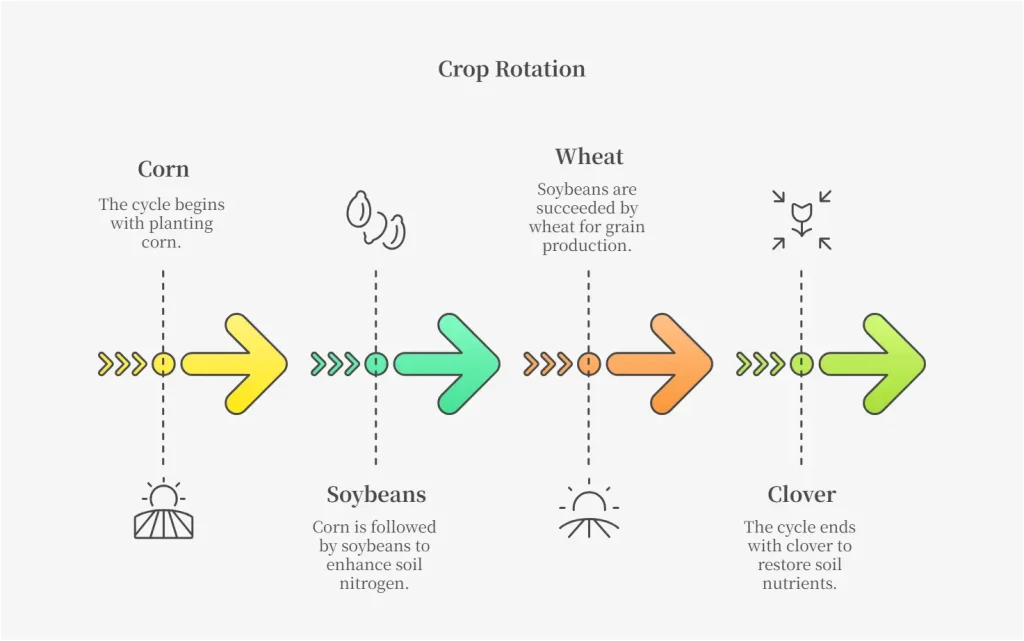Farmers have used crop rotation for centuries to keep their soil healthy and their harvests strong. This sustainable farming method involves growing different crops in the same field over time instead of planting the same crop every season.
By rotating crops, farmers prevent soil depletion, reduce pests, and boost yields naturally. But what is crop rotation?, and why does it matter?
Crop rotation is a simple yet powerful way to maintain soil fertility. For example, planting legumes like beans one season and wheat the next helps replenish nutrients.
This method also lowers the need for chemical fertilizers and pesticides, making farming more eco-friendly. What do you mean by crop rotation? It means planning carefully to ensure long-term agricultural success.
In today’s world, where soil degradation threatens food production, crop rotation remains a key solution. Understanding its benefits can help both farmers and home gardeners grow healthier, more sustainable crops.
Crop Rotation Meaning
What is crop rotation? It is a farming method where different crops are grown in the same field over different seasons. This practice prevents soil from losing essential nutrients, ensuring healthier plant growth. Instead of planting the same crop repeatedly, farmers change crops in a planned sequence.
Crop rotation is different from monocropping, where the same crop is planted season after season. Monocropping can drain the soil of nutrients, leading to lower yields and increased pests. In contrast, rotating crops helps maintain soil balance and reduces the need for chemical fertilizers.
For example, a farmer might plant corn one season and beans the next. Corn depletes nitrogen from the soil, while beans restore it. This cycle keeps the soil fertile and supports long-term farming sustainability.

What Is Crop Rotation in Agriculture?
Crop rotation plays a vital role in sustainable agriculture by improving soil health and boosting crop productivity. Farmers use this method to replenish nutrients, manage weeds, and reduce plant diseases naturally. By rotating crops, they avoid soil exhaustion and create better growing conditions.
One major benefit is nutrient management. Certain crops, like legumes, fix nitrogen in the soil, benefiting future plants. Others, like deep-rooted crops, help break up compacted soil, improving water absorption.
Weed and pest control also improve with crop rotation. When the same crop is planted continuously, pests multiply. However, changing crops disrupts their life cycle, reducing infestations naturally. For instance, rotating wheat with soybeans can limit common wheat pests, reducing the need for pesticides.
By implementing crop rotation, farmers promote soil fertility, enhance biodiversity, and reduce reliance on chemicals, making agriculture more eco-friendly and productive.
Why Is Crop Rotation Important?
Crop rotation offers several benefits, making it a key practice in modern farming.
- Enhance Soil Fertility – Different crops have unique nutrient needs. Rotating them helps maintain a balanced soil profile, preventing nutrient depletion. For example, legumes fix nitrogen in the soil, enriching it for future crops.
- Improve Soil Structure – Deep-rooted crops like sunflowers break up compacted soil, allowing water and air to penetrate. This makes the soil healthier and more productive for future planting.
- Control Pests and Diseases – Growing the same crop yearly attracts specific pests and diseases. Rotation disrupts their life cycle, reducing infestations naturally. For instance, switching from wheat to potatoes prevents certain fungal infections.
- Reduce Soil Erosion – Different crops protect the soil in unique ways. Cover crops, such as clover, hold soil in place and reduce erosion caused by wind and water.
- Increase Crop Yield – By improving soil health and reducing pests, crop rotation leads to stronger plants and higher productivity. Farmers can harvest more while using fewer chemicals.
Crop rotation is a smart farming method that ensures long-term soil sustainability and agricultural success. By using crop rotation farming, farmers create a more sustainable and profitable agricultural system while protecting the environment.
Also Read: Agroforestry: Concepts, Benefits, and Practices
How Does Crop Rotation Work?
Crop rotation follows a simple yet effective cycle to maintain soil fertility and improve plant health. The process starts with leguminous crops like beans or peas. These plants fix nitrogen in the soil, enriching it for future crops.
Next, deep-rooted crops such as carrots or sunflowers help break up compact soil layers and improve water retention. Finally, light feeder crops like leafy greens require fewer nutrients, ensuring soil balance.
A common 4-year crop rotation cycle follows this order: Year 1—corn (heavy feeder), Year 2—legumes (nitrogen fixers), Year 3—root vegetables (deep-rooted), and Year 4—small grains (light feeders). This method prevents soil depletion and enhances sustainable farming techniques.
By following these principles, farmers reduce soil erosion, limit pests, and achieve healthier crop production. Crop rotation is a simple yet powerful tool for long-term agricultural success.
Common Crop Rotation Examples
Farmers worldwide use different crop rotation cycles based on climate, soil type, and regional needs. One popular example is the corn → soybeans → wheat → clover cycle. Corn is a heavy feeder, soybeans fix nitrogen, wheat helps control weeds, and clover enriches the soil with organic matter.
In temperate regions, farmers may rotate rice → vegetables → pulses → sunflowers. This cycle ensures balanced nutrient use and protects against soil exhaustion. In dry areas, drought-resistant crops like sorghum and millet are added.
By adapting crop rotation farming to local conditions, farmers maintain soil productivity and improve overall agricultural sustainability.
Challenges in Rotating Crop in Agriculture
Despite its benefits, crop rotation presents several challenges. Initial planning can be complex, as farmers must select the right crops and timing. Some crops may require different soil conditions, making rotation tricky.
Weather conditions also play a role. Unexpected droughts or floods can disrupt planned cycles, affecting yield. Additionally, market demand fluctuates, and farmers may struggle to find buyers for rotated crops.
However, with careful planning and adaptation, these challenges can be managed. Sustainable farming practices, such as mixed cropping and organic composting, further support crop rotation’s long-term success.
Key Benefits of Crop Rotation
Soil Health Improvement – Crop rotation helps maintain nutrient balance by preventing soil depletion. Different crops have varying nutrient needs, so rotating them keeps the soil enriched. For example, legumes add nitrogen to the soil, benefiting the next crop. This process also increases organic matter, improving soil structure and water retention.
Pest and Disease Control – Growing the same crop repeatedly allows pests and diseases to thrive. Crop rotation disrupts their life cycle, reducing infestations naturally. For instance, if a field has corn one year and beans the next, pests that target corn won’t find food. This practice reduces reliance on chemical pesticides, promoting eco-friendly farming.
Increased Yield – Crop rotation improves soil health by maintaining a balanced nutrient supply. Different crops use and replenish nutrients differently, preventing soil exhaustion. Healthier soil leads to stronger plants, better resistance to diseases, and higher yields. For example, rotating nitrogen-fixing legumes with grain crops ensures sufficient nitrogen levels, boosting growth and productivity. Over time, this practice enhances farm sustainability and maximizes harvests without excessive fertilizer use.
Better Weed Management – Changing crops regularly disrupts the growth cycle of weeds, reducing their spread. Some crops, like dense-growing cereals or cover crops, naturally suppress weeds by blocking sunlight and outcompeting them for nutrients. Additionally, rotation prevents certain weed species from adapting to a single farming method. As a result, farmers rely less on chemical herbicides, making crop production more eco-friendly and cost-effective.
By rotating crops, farmers protect their soil and crops, leading to healthier and more productive farms.
Conclusion
Crop rotation is a simple yet powerful farming technique that improves soil health and controls pests naturally. It helps farmers grow stronger crops while reducing the need for artificial fertilizers and pesticides. Crop rotation practice in agriculture has been used for centuries and remains a key part of sustainable agriculture.
Adopting crop rotation can lead to better yields and healthier farms. Whether on a small garden or a large farm, it ensures long-term soil fertility and productivity. Learn more about sustainable farming techniques to make agriculture more eco-friendly and efficient!












